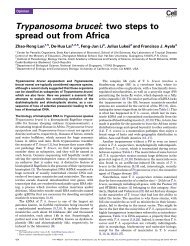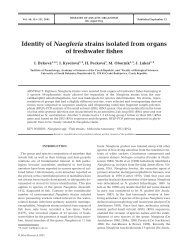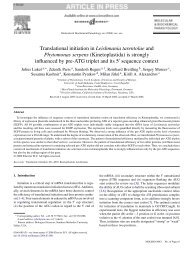Goussia Labbe´ , 1896 (Apicomplexa, Eimeriorina) - Institute of ...
Goussia Labbe´ , 1896 (Apicomplexa, Eimeriorina) - Institute of ...
Goussia Labbe´ , 1896 (Apicomplexa, Eimeriorina) - Institute of ...
You also want an ePaper? Increase the reach of your titles
YUMPU automatically turns print PDFs into web optimized ePapers that Google loves.
130 M. Jirku˚ et al.<br />
Experimentally infected R. dalmatina tadpoles<br />
invariably shed low numbers <strong>of</strong> oocysts 25—35<br />
days post infection. Both fresh and histological<br />
preparations from tadpoles at the onset <strong>of</strong> oocyst<br />
shedding revealed terminating infections manifested<br />
by high numbers <strong>of</strong> sporogonic stages and<br />
significant histopathological changes <strong>of</strong> intestinal<br />
epithelia, suggesting delay <strong>of</strong> oocyst shedding,<br />
which hampered evaluation <strong>of</strong> the length <strong>of</strong><br />
prepatent period.<br />
Phylogenetic analysis: Comparison between<br />
G. noelleri, <strong>Goussia</strong> sp. from B. bufo and G.<br />
neglecta showed 96—97% similarity <strong>of</strong> SSU rDNA<br />
sequences. In our analysis (Fig. 24), three main<br />
coccidian clades — eimeriid, sarcocystid and<br />
adeleid — were recognized. Within Eimeriidae<br />
sensu lato (s.l.) (the sister clade <strong>of</strong> the sarcocystid<br />
lineage), the basal clades were invariably formed<br />
by taxa from the poikilotherm hosts, i.e. an<br />
unspecified intranuclear coccidium, Choleoeimeria<br />
sp., <strong>Goussia</strong> metchnikovi, anuran <strong>Goussia</strong><br />
isolates, Eimeria tropidura, Eimeria arnyi and<br />
E. ranae. The only exceptions from this pattern<br />
are Lankesterella minima and Caryospora bigenetica<br />
with unstable position(s) in different analyses,<br />
both also from poikilotherms. E. tropidura<br />
clustered together with Choleoeimeria sp. and<br />
formed a well-supported lineage, which is sister to<br />
the clade comprising all Stieda body-bearing<br />
eimeriid coccidia. All <strong>Goussia</strong> sequences, except<br />
that <strong>of</strong> G. janae, appeared in all analyses at the<br />
base <strong>of</strong> the eimeriid clade. All three anuran<br />
<strong>Goussia</strong> isolates formed a distinct clade supported<br />
by high bootstrap values, with G. noelleri<br />
and <strong>Goussia</strong> sp. from B. bufo being closely related.<br />
Although the anuran <strong>Goussia</strong> clade together<br />
ARTICLE IN PRESS<br />
Table 2. Results <strong>of</strong> transmission experiments with <strong>Goussia</strong> isolates.<br />
Experimental animals Origin <strong>of</strong> infectious material<br />
Rana dalmatina Rana temporaria Bufo bufo<br />
Rana dalmatina 2/2 1/2 1/2*<br />
Rana temporaria 2/2 2/2* 0/2*<br />
Pelophylax kl. esculentus 1/2* 2/2* 1/1*<br />
Bufo bufo 2/4* 1/2* 1/2*<br />
Hyla arborea 0/1 — —<br />
Xenopus laevis tadpoles 0/4 0/2 0/1<br />
Xenopus laevis adults 0/4 adults — —<br />
Pleurodeles waltl larvae 0/1 0/1 —<br />
Pleurodeles waltl adults 0/4 adults — —<br />
No. <strong>of</strong> experimental trials resulting in infections/No. <strong>of</strong> experimental trials conducted. Each trial involved 50<br />
experimental tadpoles, except for H. arborea and P. waltl when 20 individuals were used in each trial. Stars (*)<br />
indicate trials in which negative controls became infected.<br />
with a lineage represented by G. metchnikovi form<br />
a polytomy, their position at the base <strong>of</strong> the clade<br />
comprising all remaining eimeriids was stable in all<br />
performed analyses. G. janae represents a distinct<br />
lineage sister to the clade comprising all the<br />
other eimeriorinid coccidia (Sarcocystidae and<br />
Eimeriidae) which parasitize vertebrate hosts.<br />
Discussion<br />
Identity <strong>of</strong> G. neglecta<br />
Our data showed that the concept <strong>of</strong> a single<br />
<strong>Goussia</strong> sp. in European anurans is unsustainable.<br />
G. neglecta was described from Hamburg in<br />
Germany from insufficiently determined anurans<br />
(Nöller 1920). In 1995, Molnár redescribed<br />
G. neglecta based on light-microscopic observations<br />
<strong>of</strong> material from P. kl. esculentus and<br />
Pelophylax ridibundus, without proposing a type<br />
host. Recently, Duszynski et al. (2007) justifiably<br />
proposed P. kl. esculentus as the type host <strong>of</strong><br />
G. neglecta, but provided Hamburg as the type<br />
locality. This act erroneously blends together<br />
the incomplete description by Nöller (1920) with<br />
Molnár’s (1995) redescription. To correct this<br />
confusion, we suggest to fully accept the redescription,<br />
and propose P. kl. esculentus as the<br />
type host, and Százhalombatta in Hungary as the<br />
type locality <strong>of</strong> G. neglecta.<br />
Unmasked Diversity <strong>of</strong> Anuran <strong>Goussia</strong><br />
The distribution pattern <strong>of</strong> <strong>Goussia</strong> infections at different<br />
localities with similar amphibian communities








